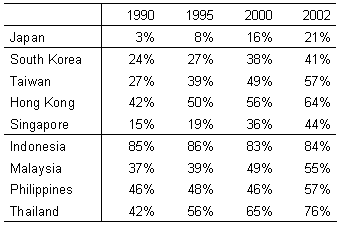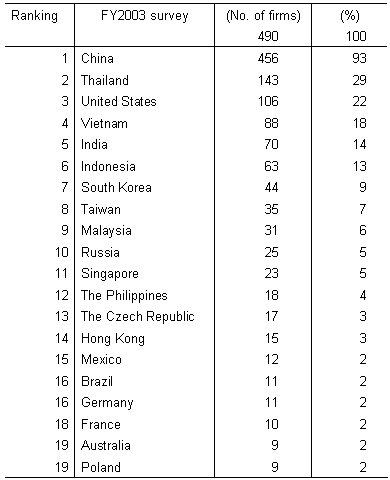While Japan and China are in a complementary relationship, the ASEAN countries and China are in a competitive one. This reflects the fact that while a large gap remains between China and Japan in terms of their stages of economic development, China is swiftly catching up with ASEAN. When two countries are in a complementary relationship, it is a win-win game with much room for cooperation. However, a competitive relationship threatens to become a zero-sum game. As we have already confirmed in this column using U.S. import statistics, products from China and ASEAN are in fierce competition that is intensifying every year ( table 1 ).
This is not only visible on the trade front, but can also be seen in the overseas direct investment trends of Japanese firms. According to overseas foreign direct investment figures released by the Ministry of Finance, investment in China in fiscal 2002 rose by 19.1% up on the previous year. In contrast, investment in ASEAN is declining across the board. The results of a fiscal 2003 survey on overseas direct investment conducted by the Research Institute for Development and Finance in the Japan Bank for International Cooperation released in November also showed that manufacturers are placing greater priority on China rather than ASEAN as the base for their overseas operations.
First, from the viewpoint of evaluating the performance of their overseas operations, firms are beginning to rate China at the same level as ASEAN members. Profitability evaluations for ASEAN have been declining over the past decade, but China is registering a rise, albeit a gradual one. In fiscal 2003, especially, the number of firms saying they are satisfied with profitability is rising as their facilities begin full-fledged operations. Meanwhile, Japanese companies that have made inroads into ASEAN are taking increasing notice of Chinese firms, rather than other Japanese companies and U.S. or European firms, as their competitors in both local and export markets.
In addition, of the Japanese firms that have directly invested in China, 73.9% said they plan to strengthen or expand their operations there in the midterm, while the corresponding figure for ASEAN was only 42.7%. On the other hand, while 0.2% said they might reduce or withdraw their operations from China, 4% replied that they might do so with their ASEAN operations. One reason why there was a marked trend to strengthen operations in China compared to ASEAN is that China won high marks not just as a low-cost production base but also for its potential as a market for these firms' products, as well as the fact that their business partners are entering or expanding operations there.
Furthermore, when all companies responding to the survey were asked to pick one or more countries they felt were promising places to conduct business in the mid-to-long term (the next three years or so) regardless of where they currently had operations, China easily came out on top, being named by 93% of respondents, while Thailand - the leader among ASEAN members - was placed a distant second with 29% and the U.S. was third with 22% ( table 2 ). Of the companies that consider China to be a promising place to invest, 70.8% said they had specific business plans, indicating that their evaluation of China is not just based on vague expectations.
Such evaluations indicate that the center of gravity of Japanese firms' operations in Asia will continue to shift from ASEAN to China. Direct investment from Japan has greatly contributed to the industrialization of the ASEAN countries, and its decrease could slacken the pace of the region's economic development.
Table 1: Competition between Asian nations and China in the U.S. market

(Source) U.S. import statistics (some 10,000 product categories of manufactured goods based on the 10-digit HS commodity classification system)
Table 2: Promising countries for midterm (ie in the next 3 years) business expansion (multiple answers)

(Source)Research Institute for Development and Finance, Japan Bank for International Cooperation, "Survey Report on Overseas Business Operations by Japanese Manufacturing Companies" (November 2003).


